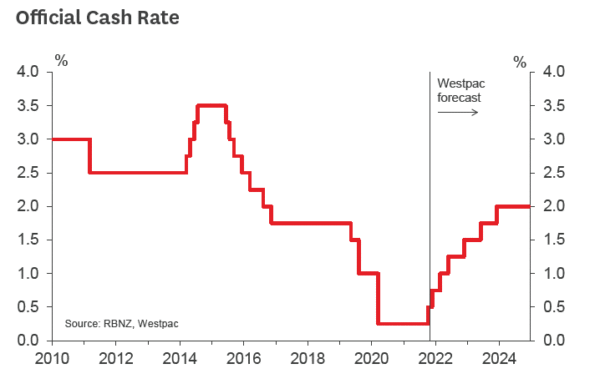- The Reserve Bank increased the OCR by 25 basis points to 0.50% as expected, and signalled further reductions in stimulus over time.
- The current Covid-19 outbreak and restrictions have dampened activity in the near term.
- But this has not materially affected the central bank’s medium-term focus.
- Strong demand and a tight labour market increase the risk that near-term price pressures turn into something more persistent.
- We expect further OCR hikes at the November, February and May reviews.
Today’s increase in the Official Cash Rate was widely expected. Despite the uncertainty created by the latest Covid-19 outbreak, the Reserve Bank has remained clear about its intentions to start removing monetary stimulus from the economy. (Indeed, it had arguably started the process already by ending the Large-Scale Asset Purchase programme in July.) Our view remains that we’ll see further rate hikes at the upcoming policy reviews.
The RBNZ did show that it’s sensitive to the fact that many businesses are hurting as a result of the current restrictions, most obviously in Auckland but also elsewhere. It noted that strong balance sheets coming into the lockdown, and renewed fiscal policy support, have helped to soften the blow, and that the evidence to date suggests that activity has again rebounded quickly where restrictions have been lifted.
Despite the near-term pain, the RBNZ’s eyes remain on its medium-term inflation and employment goals. On that front, it noted that conditions have not materially changed since the August Monetary Policy Statement, when the RBNZ would most likely have hiked the OCR if not for the timing of the current lockdown
Indeed, there’s an important point to be made here about the economic outlook over the medium term. The endgame of our Covid strategy was always going to be to get high levels of vaccination, to move away from restrictions on activity, and accept that there will be ongoing cases in the community (but with few of them being severe, because of the vaccine). We’re still heading to that destination – perhaps by early next year – it’s just that the journey there is going to be rockier than we would have liked.
As we move forward, the pressures that the RBNZ was facing before this outbreak will come to the fore again. Inflation has already lifted sharply this year, and is set to go higher, due to a range of factors such as global supply chain disruptions, soaring shipping costs, rising energy prices, and intense competition for workers due to skills shortages.
Price pressures are not the only issue here. There was substantial evidence that demand in the economy was running hot before this lockdown, and that is likely to return as restrictions are lifted. Strong demand increases the risk that seemingly temporary price shocks can translate through into broader, more persistent inflation pressures – and that’s where a monetary policy response is appropriate.
The RBNZ noted that “employment is expected to remain at around its maximum sustainable level”. But there’s a growing risk of moving beyond that point. Yesterday’s Quarterly Survey of Business Opinion was quite telling: even in the face of the current lockdown, demand for workers has surged, and expectations of labour turnover (i.e. poaching) have gone ballistic. While it’s easy to view this as a capacity constraint – the closure of the border has largely cut off access to migrant workers – the fact that businesses are willing to pay up to attract people from the existing workforce reveals that this is really a story of strong demand
Looking ahead, we continue to expect further rate hikes of 25 basis points at the November, February and May Monetary Policy Statements. That would be a total increase of 100 basis points, after which we expect the RBNZ to pause to assess their impact. That won’t be the end of it – we expect a further gradual tightening over the following years – but the RBNZ is likely to move more cautiously as it gets closer to what it considers to be a ‘neutral’ level for the OCR.
Financial markets were largely priced for a 25 basis point hike today, though not entirely in light of the most recent Covid developments. As such, there was a brief lift in the New Zealand dollar after the announcement, but it was very short-lived.














